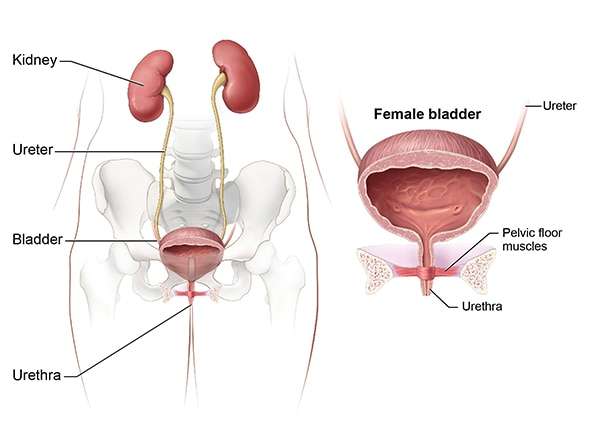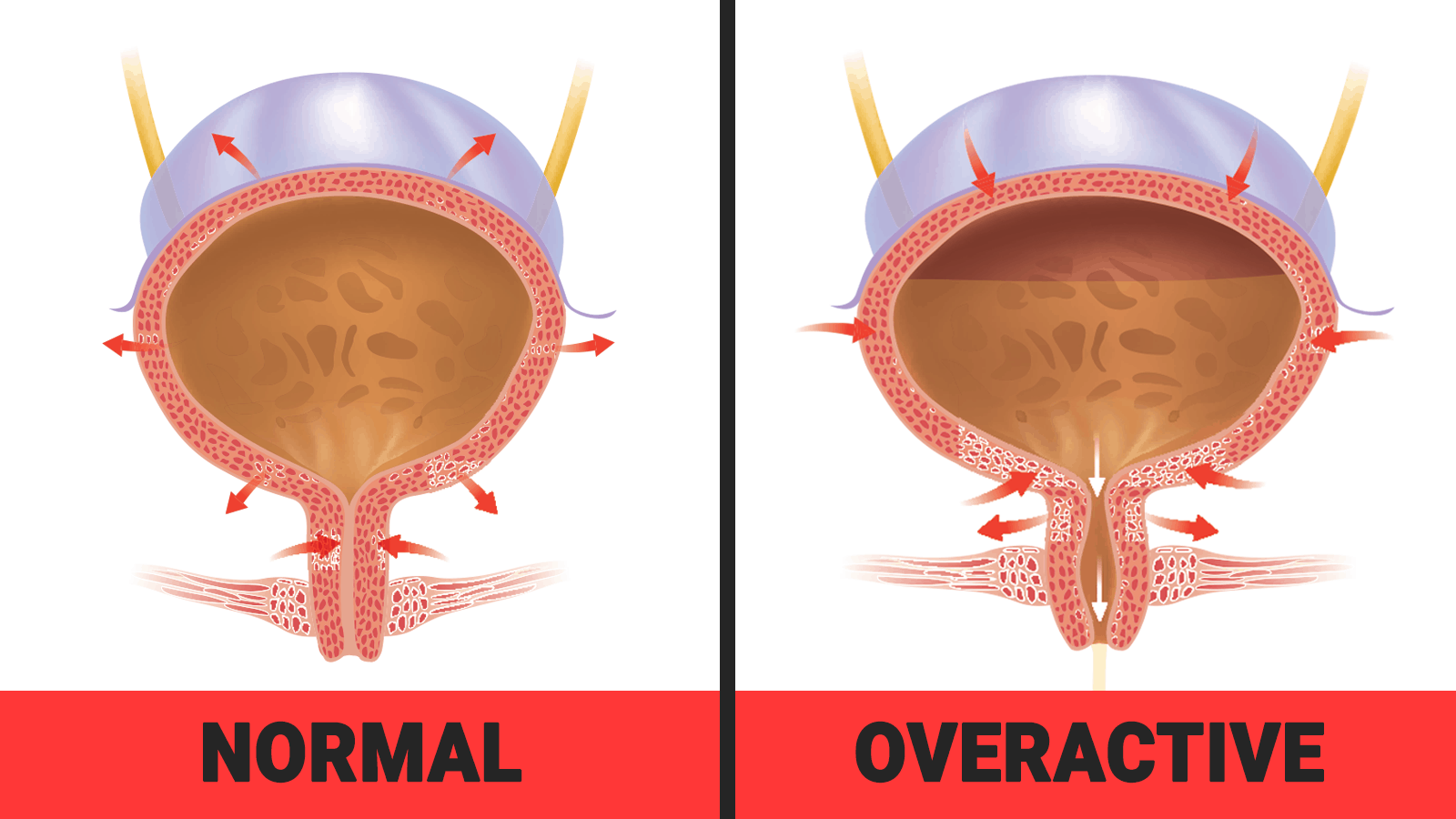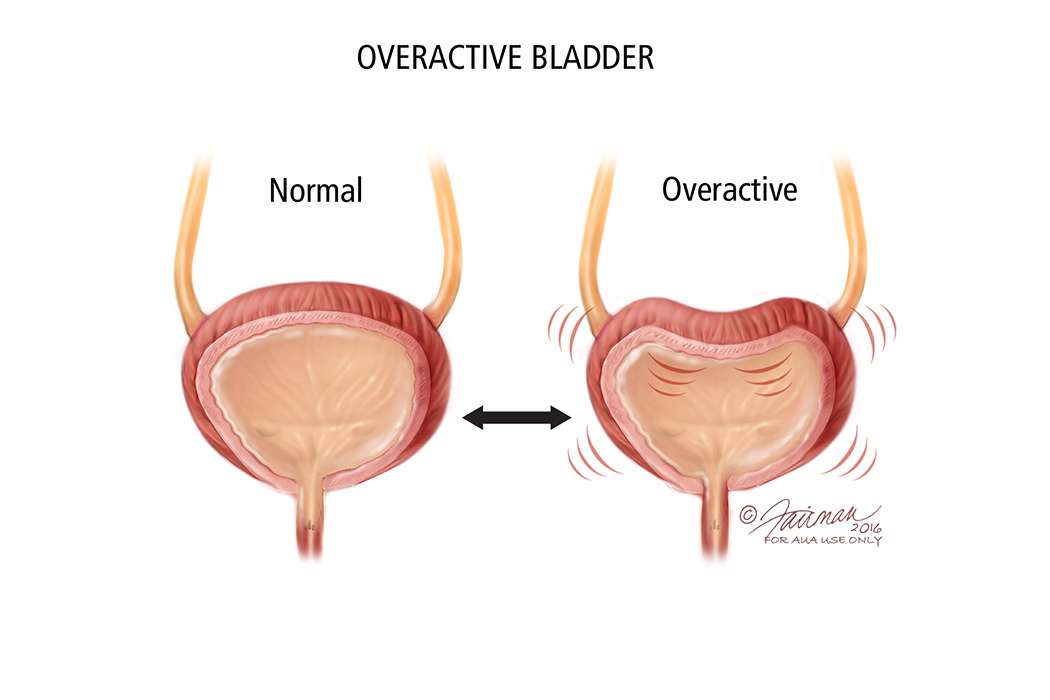Bladder Training For Urinary Incontinence
Stick to a Schedule
Bladder training is a useful way to treat both common forms of urinary incontinence. To implement this training, go to the bathroom at set times to urinate. The goal is to urinate frequently enough that it minimizes urges to void and accidents. As the bladder strengthens and accidents are less frequent, you can increase the length of time between bathroom trips. Stick to the schedule whether or not you feel the need to urinate. If your goal is visit the restroom every hour and 15 minutes, do so to help decrease your symptoms.
Length of Training
Training may take between 3 and 12 weeks or longer. During the program, the physician may ask you to keep a diary of your bathroom habits including when and how much you urinate. You may be asked to record your fluid intake and if and when you have any accidents and how much you lose at a time. This information will help you and your health professional identify triggers for your symptoms and help optimize treatment.
Overactive Bladder In Women
Women are more likely to report symptoms of OAB to their doctor. In fact, at least 40 percent of American women experience symptoms of overactive bladder. Many more may not report the experiences to their doctor at all.
Overactive bladder consists of a series of symptoms that cause you to need to urinate more frequently. These symptoms include
- feeling a sudden need to urinate
- not being able to control urination
- urinating at least two times every night
- urinating at least eight times every day
Its not clear what causes overactive bladder, but OAB becomes more common in women after menopause. That may be the result of estrogen deficiency. However, overactive bladder can occur at any age.
Overactive bladder is a common childhood condition, but not every accident or soiled bed is the result of OAB. Children frequently grow out of overactive bladder symptoms, but treatment can help prevent frequent urination or complications.
Symptoms of OAB in children include:
- an urgent or frequent need to urinate
- accidents or leaking urine
- urinating more than eight times in a day
- not feeling as if theyve emptied their bladder despite urinating
Symptoms of OAB become less common as children get older. With age, kids learn to properly control their bladder and recognize signals that they need to urinate. If symptoms of overactive bladder dont seem to be resolving or are getting worse, talk with your childs doctor.
Causes of OAB in children include:
- urinary tract infection
What Steps Can I Take At Home To Treat Urinary Incontinence
Your doctor or nurse may suggest some things you can do at home to help treat urinary incontinence. Some people do not think that such simple actions can treat urinary incontinence. But for many women, these steps make urinary incontinence go away entirely, or help leak less urine. These steps may include:
You can also buy pads or protective underwear while you take other steps to treat urinary incontinence. These are sold in many stores that also sell feminine hygiene products like tampons and pads.
Read Also: What Causes Overactive Bladder In Women
Coping With Incontinence: Lifestyle Changes
But for most women, a little absorbent pad is their first weapon, a lifestyle change their second.
For many women the change may be as simple as drinking less water.
“You can’t drink two big bottles of water at one time, because it comes through your system as one big of fluid,” says Brubaker. “If you have a little at a time, it’s much easier for the bladder.”
“Also, caffeine is a diuretic, so Cokes, coffee, any drink with caffeine make you leak more,” Brubaker explains. “You need to cut back.”
Perhaps you just need to urinate more frequently – especially before getting onto the tennis court, for example.
You may also simply learn to brace yourself when you laugh or cough, tightening your pelvic muscles to prevent leaks.
“Women are smart…” says Brubaker. “They try a bunch of things on their own before they get the gumption to talk to someone about it.”
How Can Nerve Stimulation Help Overactive Bladder

There are several treatments that involve stimulating your nerves to help improve overactive bladder. Your nerves help communicate the message that your bladder needs to be emptied to your brain. By treating the nerves, your healthcare provider can improve your bladder control. Nerve stimulation is a reversible treatment that is considered when conservative treatments have not worked or have not been tolerated. Conservative treatments include behavioral therapies and medications.
There are several types of nerve stimulation treatments. These can include:
Recommended Reading: How To Relieve Bladder Spasms With Catheter
Physical Blockage In The Lower Urinary Tract
For women, any blockage in the lower urinary tractthe bladder and urethracan also lead to urinary retention.
The blockage can be inside the bladder, such as in the case of bladder stones or tumors.
The neck of the bladder can be obstructed in what is known as bladder outlet obstruction . This condition in women is rare and poorly understood.
The urethra can also be obstructed in what is known as urethral stricture. Scar tissue formed by previous urethral trauma can obstruct the urethra. Infections can also cause swelling which narrows the urethra.
Causes Of Urinary Incontinence
Stress incontinence is usually the result of the weakening of or damage to the muscles used to prevent urination, such as the pelvic floor muscles and the urethral sphincter.
Urge incontinence is usually the result of overactivity of the detrusor muscles, which control the bladder.
Overflow incontinence is often caused by an obstruction or blockage in your bladder, which prevents it from emptying fully.
Total incontinence may be caused by a problem with the bladder from birth, a spinal injury, or a small, tunnel like hole that can form between the bladder and a nearby area .
Certain things can increase the chances of urinary incontinence, including:
- pregnancy and vaginal birth
Find out more about the causes of urinary incontinence.
Don’t Miss: Doterra Oils For Bladder Infection
Try To Prevent Constipation
Constipation causes the colon to swell and strain because of increased abdominal muscle pressure. This can adversely affect the bladder muscles and may also increase the frequency and severity of OAB symptoms.
Eating more fiber, getting regular exercise, and staying hydrated can help prevent constipation. In addition, there are certain yoga poses including the Crescent Lunge, Cobra, and Legs up the Wall that can help relieve constipation and promote healthy bowel movements.
Those who experience chronic constipation should talk with a doctor to learn more about other ways to help manage their constipation more effectively, such as by taking medications or trying physical therapy.
Do The Right Exercises
High-impact exercise and sit-ups put pressure on your pelvic floor muscles and can increase leaks.
To strengthen your pelvic floor to relieve symptoms, replace high-impact exercise, such as jogging and aerobics, with strengthening exercise, such as pilates.
Pilates strengthens your core muscles, which is beneficial for stress incontinence.
Recommended Reading: Can Lower Back Pain Cause Bladder Problems
Duration Of Urinary Incontinence
Most cases of UI are chronic, and will remain so until treated. Depending on the cause, however, not all UI cases are chronic. If the cause is temporary, such as a vaginal infection or a urinary tract infection, the UI will stop once the issue is addressed.
RELATED: What Do the Color and Smell of Your Urine Tell You?
Incontinence And Emotional Health
Quality of Life Issue
Incontinence can take a serious toll on quality of life. Women who are affected by it report more depression and limitations in sexual and social functioning than those who do not have the condition. Those who suffer from this health concern are more likely to rely on caregivers. Incontinence also has a negative effect on self-esteem. In general, it negatively affects a woman’s quality of life, the more she should seek aggressive treatment.
An Honest Conversation
Many women feel embarrassed about suffering from incontinence, but they need not. This is a common problem and you are not alone. Effective treatments are available. Be honest with your doctor. Do you avoid certain activities because of your symptoms? Does incontinence impair your work, sleep, sex life, or social functioning? Different interventions are available depending on how it impacts you. Speaking candidly with your doctor is the best way to identify treatments that are most appropriate for your situation.
Read Also: Botox Injection For Bladder Incontinence
Why Does My Dog Have A Weak Bladder
A weak bladder sphincter is the most common cause of incontinence.
Spayed females are most susceptible to a weakened bladder sphincter due to low estrogen levels along with other factors and can be affected at any age after spaying.
Female dogs with this type of incontinence will commonly respond to hormone treatment.
What Is Overactive Bladder

OAB Basics
The condition known as overactive bladder may or may not be associated with urge incontinence. OAB refers to sudden, uncontrollable bladder contractions. When these contractions are associated with leaks, urge incontinence is also present. OAB is disruptive because strong, frequent bladder contractions prompt numerous trips to the bathroom throughout the day and sometimes also at night. OAB can interfere with work, fitness, and social life. If you get up multiple times at night to urinate, OAB can also keep you from getting a good night’s sleep.
A Common Problem
OAB is an extremely common disorder. Approximately 33% of people in the United States have OAB. An estimated 40% of women in the U.S. have the condition. Despite the fact that millions of people and a large percentage of women have OAB, it is not normal and you don’t have to live with uncomfortable, limiting symptoms. There are treatments that can help.
Read Also: Over The Counter Bladder Medication
What Is Overactive Bladder Syndrome
Overactive bladder syndrome means that the bladder, which is a bag made of muscle, squeezes suddenly without you having control and when the bladder is not full. OAB syndrome is a common condition where no cause can be found for the repeated and uncontrolled bladder contractions.
Overactive bladder syndrome is more common in women than in men, so is included in our women’s health information. However, this problem can affect men as well as women.
OAB syndrome is sometimes called detrusor instability or overactivity or an irritable bladder.
What Causes A Weak Bladder
Ever find yourself pondering – why is my bladder so weak?.
Or maybe youre wondering whether your seasonal allergies could be aggravating your weak bladder, where the worst thing about having to constantly sneeze and cough isnt the stuffy head or nose – its the urine leakage that occurs.
Bladder weakness is not something that any woman should have to live with and INNOVO are passionate about giving women back control over their lives by alleviating the symptoms of bladder weakness.
In this article well cover:
- Can seasonal allergies cause bladder weakness?
- What bladder weakness is
- What causes a weak bladder
- How you can help alleviate symptoms of bladder weakness
Also Check: Can You Have A Bladder Infection Without Symptoms
What Are The Symptoms Of Urinary Incontinence
The following are common symptoms of urinary incontinence. However, each individual may experience symptoms differently. Symptoms may include:
-
Needing to rush to the restroom and/or losing urine if you do not get to the restroom in time
-
Urine leakage with movements or exercise
-
Leakage of urine that prevents activities
-
Urine leakage with coughing, sneezing or laughing
-
Leakage of urine that began or continued after surgery
-
Leakage of urine that causes embarrassment
-
Constant feeling of wetness without sensation of urine leakage
-
Feeling of incomplete bladder emptying
The symptoms of urinary incontinence may resemble other conditions or medical problems. Always consult your doctor for a diagnosis.
7 Things You Should Always Discuss with Your Gynecologist
When it comes to sexual and reproductive health, it can be hard to know whats normal and what may be a sign of a potential health problem. Even if you feel embarrassed about certain issues, your gynecologist has seen and heard it all and is there to help you, not to pass judgment.
What Is Urinary Incontinence Symptoms Causes Diagnosis Treatment And Prevention
Urinary incontinence , the involuntary loss of urine, is a very common condition that no one wants to talk about. Because of the stigma that surrounds it, many people are too humiliated to seek help. But most conditions that cause UI can be corrected with medical or alternative interventions.
Occurring much more often in women than men, UI happens when the muscles in the bladder that control the flow of urine contract or relax involuntarily, resulting in leaks or uncontrolled urination. UI itself is not a disease, but it can be a symptom of an underlying medical issue.
You May Like: Botox Dose For Overactive Bladder
Symptoms Of Stress Incontinence
Common in Women
Stress incontinence occurs when pelvic floor muscles weaken. The condition is the most common type of urinary incontinence in young women. Stress incontinence is the second most common type in older women. Activities like exercise, walking, stretching, bending, laughing, coughing, sneezing, or lifting place strain on weakened pelvic floor muscles, and that leads to leaks. Any activity that increases physical strain on pelvic floor muscles may lead to stress incontinence–even sex. The amount that leaks varies. It may be a few drops or up to a tablespoon or more, depending on severity.
Prevalence
Some studies suggest 24% to 45% of women over the age of 30 suffer from stress incontinence. If you suffer from urinary incontinence, you are definitely not alone. Weakness in not just the pelvic floor muscles, but also in the urethral sphincter often plays a role in this type of urinary incontinence.
What Are The Normal Conditions
Average urine flow is based on the age and sex of a person. Typically, urine flow runs from 10 ml to 21 ml per second. Among women, the normal range is closer to 15 ml to 18 ml per person. A low or low flow of urinating rate could suggest there is an obstruction at the bladder neck or in the urethra, a weak bladder, or an enlarged prostate.
You May Like: Can A Ct Urogram Detect Bladder Cancer
What Causes Overactive Bladder
An overactive bladder can be caused by several things, or even a combination of causes. Some possible causes can include:
- Weak pelvic muscles: Pregnancy and childbirth can cause your pelvic muscles to stretch and weaken. This can cause the bladder to sag out of its normal position. All of these factors can cause leakage.
- Nerve damage: Sometimes signals are sent to the brain and bladder to empty at the wrong time. Trauma and diseases can cause this to happen. These can include:
- Pelvic or back surgery.
- Stroke.
Often, there may be no specific explanation for why this is occurring.
Sudden Onset Urinary Incontinence: Causes And Treatment

Lets face it, urinary incontinence is embarrassing to talk about. Knowing that every time you laugh, cough, sneeze, or exercise could cause you to start leaking urine before you reach the bathroom is something no one wants to face.
First off, know that you are not alone. Sudden onset urinary incontinence affects nearly one-third of the entire US population.
This common condition can be treated, but you need to take those first, hard steps and speak to your doctor. The sooner you do, the better chance you have in a successful treatment.
The problem is, how do you know what caused this sudden incontinence? Knowing what caused it will help both you and your doctor find the appropriate treatment for it.
Thankfully, we have detailed information on how you can discover what caused your sudden onset urinary incontinence, and information on what types of treatment are available.
Keep on reading to learn more.
Also Check: How To Fix Bladder Leakage After Pregnancy
Amping Up Your Treatment: Medications And Surgery
When more conservative measures have failed, medications – then surgery – are the alternatives, says Galloway.
Medications: No drug helps with stress incontinence, but a class called anticholinergics does help with urge incontinence.
These drugs include Detrol, Oxytrol, Ditropan, and Sanctura — all with similar effectiveness and similar side effects, like dry mouth and constipation, says Galloway.
Medications like Enablexand Vesicare are more effective in controlling the bladder, but don’t cause constipation, he adds.
A transdermal patch called Oxytrol has also been effective, says Galloway, who adds that skin irritation at the patch site does occur in some patients.
Surgery: There are 300 surgical options to treat incontinence, says Brubaker.
“The hard part is picking the surgery that has the best chance of working well for that woman long-term,” he says. “Surgery can create problems. It can cause difficulty in urinating, worsen an urge incontinence problem, or it can do nothing to solve the problem.”
A large NIH study is examining the use of a sling — a medical device that is surgically inserted into the vagina and positioned underneath the urethra, says Brubaker.
“It helps the urethral sphincter remain closed when abdominal pressure tries to open it. At least, we think that’s how it works,” he says. “We have only five-year outcomes on one group of these devices. But they look promising.”
Show Sources